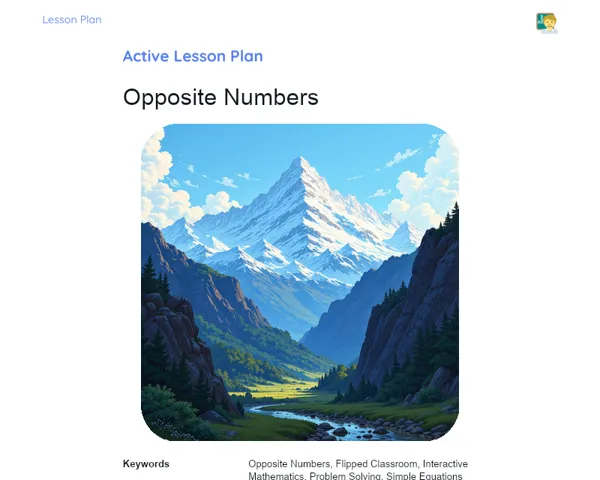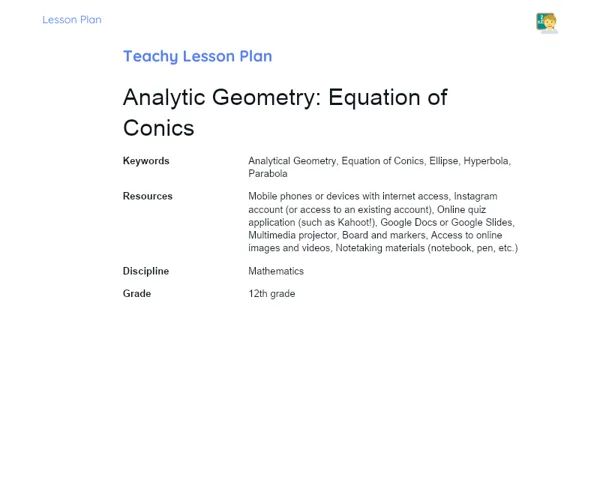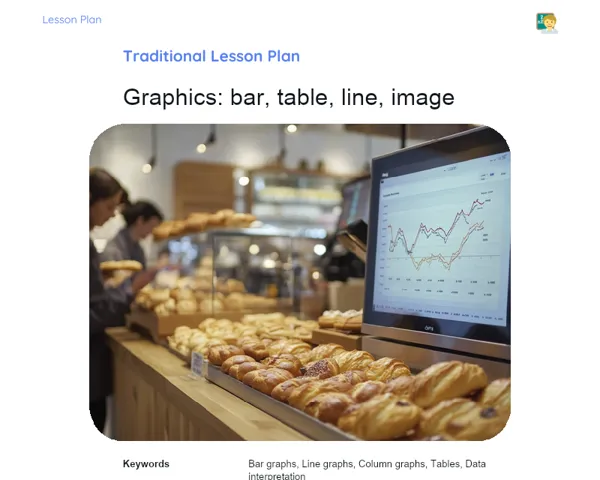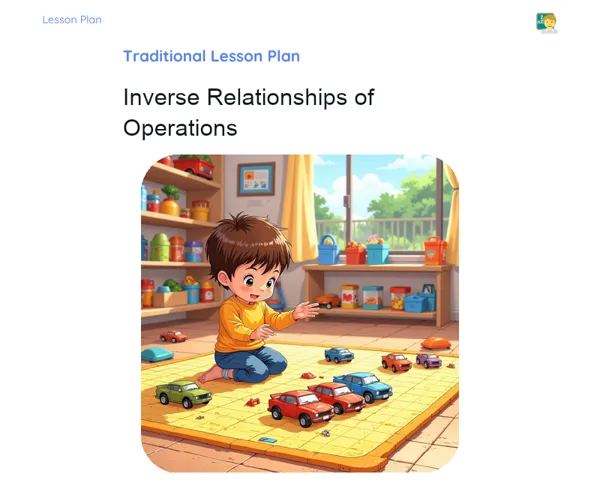Lesson Plan | Lesson Plan Tradisional | Triangle Existence Condition
| Keywords | Triangle, Geometry, Condition for Existence, Sum of the Sides, Practical Examples, Counterexamples, Engineering, Architecture, Computer Graphics, Structural Stability, 3D Modeling |
| Resources | Whiteboard, Markers, Ruler, Paper, Pencil, Erasers, Projector (optional), Presentation slides (optional), Worksheets |
Objectives
Duration: (10 - 15 minutes)
The goal of this stage is to give students a clear understanding of the metric conditions that determine the formation of a triangle. By describing and illustrating these conditions, students will learn to identify and apply the triangle inequality, which is vital for constructing triangles in various geometric scenarios.
Objectives Utama:
1. Explain the essential conditions required for constructing a triangle.
2. Show practical examples illustrating the triangle inequality.
3. Ensure students accurately recognise and apply the criteria for forming a triangle.
Introduction
Duration: (10 - 15 minutes)
🏆 Purpose: This stage aims to furnish students with a solid understanding of the metric conditions that determine the existence of a triangle. Through description and examples, students will grasp how to identify and apply the triangle inequality, which is essential in different geometric situations.
Did you know?
🤔 Fun Fact: Did you know that the triangle inequality is crucial in fields like engineering? For instance, when constructing bridges, engineers depend on triangles to ensure the stability of the structures. Moreover, this principle is key in computer graphics and animations, where triangles are foundational for creating 3D models.
Contextualization
🔍 Context: Kick off the lesson by defining a triangle for the students. A triangle is a geometric shape that has three sides. It is one of the simplest and most essential forms in geometry, found in many real-life applications like building design, engineering, and art. Understanding the conditions necessary for a triangle will help students figure out when three line segments can indeed make a triangle.
Concepts
Duration: (40 - 50 minutes)
This stage aims to deepen students' understanding of the conditions for triangle existence through detailed explanations, practical examples, and counterexamples. By the end of this segment, students should be able to apply the triangle inequality across various situations and recognise when three line segments can or cannot form a triangle.
Relevant Topics
1. Definition of Triangle: Explain that a triangle is a shape with three sides. Emphasise that it is one of the most fundamental forms in geometry.
2. Condition for the Existence of a Triangle: Clarify that for three line segments to create a triangle, the sum of the lengths of any two sides must exceed the length of the third side. Use the formula: If a, b, and c are the triangle's sides, then a + b > c, a + c > b, and b + c > a.
3. Practical Examples: Provide simple numerical examples to illustrate the conditions. For example, if the sides measure 3, 4, and 5, show that 3 + 4 > 5, 3 + 5 > 4, and 4 + 5 > 3 confirm that they indeed form a triangle.
4. Counterexamples: Present examples where the conditions are not fulfilled. For instance, with sides of 2, 2, and 5, demonstrate that 2 + 2 is not greater than 5, thus these sides cannot form a triangle.
5. Practical Applications: Discuss how this condition is relevant in various fields such as civil engineering, architecture, and computer graphics, to ensure the viability and stability of structures and models.
To Reinforce Learning
1. Check if the segments measuring 7, 10, and 5 can form a triangle. Justify your answer.
2. Determine if the segments measuring 3, 4, and 8 can create a triangle. Explain your reasoning.
3. Given a triangle with sides measuring 6, 8, and 10, verify if it satisfies the conditions for triangle existence. Show your working.
Feedback
Duration: (20 - 25 minutes)
This stage reviews and consolidates students' understanding of triangle existence conditions. By thoroughly discussing the answers to the questions and engaging students in further reflections, we ensure they appreciate not just the rule itself but its practical application and relevance in various contexts.
Diskusi Concepts
1. Discussion of the Questions: 2. Question: Can the segments measuring 7, 10, and 5 form a triangle? Justify your answer. 3. Explanation: To determine if the segments can create a triangle, we need to check the three conditions: 4. 7 + 10 > 5: 17 > 5 (True) 5. 7 + 5 > 10: 12 > 10 (True) 6. 10 + 5 > 7: 15 > 7 (True) 7. Conclusion: Since all conditions are true, the segments 7, 10, and 5 can indeed form a triangle. 8. Question: Can the segments measuring 3, 4, and 8 form a triangle? Explain your reasoning. 9. Explanation: To assess if the segments can form a triangle, we need to evaluate the three conditions: 10. 3 + 4 > 8: 7 > 8 (False) 11. 3 + 8 > 4: 11 > 4 (True) 12. 4 + 8 > 3: 12 > 3 (True) 13. Conclusion: Since one of the conditions is false (3 + 4 is not greater than 8), segments 3, 4, and 8 cannot form a triangle. 14. Question: Given a triangle with sides measuring 6, 8, and 10, verify if it fulfills the conditions for triangle existence. Show your calculations. 15. Explanation: To check if these segments can create a triangle, we need to evaluate the three conditions: 16. 6 + 8 > 10: 14 > 10 (True) 17. 6 + 10 > 8: 16 > 8 (True) 18. 8 + 10 > 6: 18 > 6 (True) 19. Conclusion: Since all conditions are true, segments 6, 8, and 10 can form a triangle.
Engaging Students
1. Questions and Reflections: 2. How would you check the condition for forming a triangle in a real-world situation, such as in bridge construction? 3. If you only had two measurements of line segments, how could you determine the range of possible values for the third segment to form a triangle? 4. Why is the condition for triangle existence significant in fields like computer graphics and civil engineering? 5. Can you think of other geometric shapes where a similar existence condition might apply? 6. How can mastering the condition for forming a triangle aid you in other geometry topics?
Conclusion
Duration: (10 - 15 minutes)
This stage is meant to review and consolidate the key points covered during the lesson, ensuring students grasp the link between theory and practice, stressing the importance of the topic for real-world applications, and reinforcing the relevance of their learning.
Summary
['Definition of a triangle as a geometric figure with three sides.', 'Condition for triangle existence: the sum of any two side lengths must exceed the length of the third side.', 'Examples showing when three segments can or cannot form a triangle.', 'Application of these conditions in fields like civil engineering, architecture, and computer graphics.']
Connection
The lesson connected the theory of triangle existence conditions with practice using numerical examples and counterexamples while addressing real-world applications in civil engineering and computer graphics to demonstrate the importance of these conditions for structural stability and viability.
Theme Relevance
Understanding the triangle existence condition is fundamental in everyday life, as this rule is used in various practical fields. For example, in bridge construction, triangles provide structural stability. Additionally, in computer graphics, triangles are the basis for 3D object modeling, emphasising this concept's practical significance.



